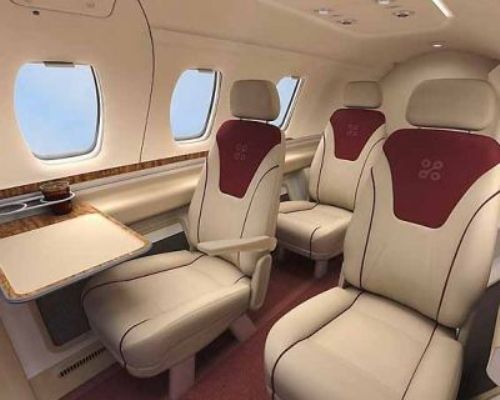


Aircraft Description
The main objective of Albuquerque-based Eclipse Aviation was to construct a private jet that was affordable (less than $1 million), yet still offered great performance and amenities. However, the process was a bit of trial and error. The Eclipse 500 first flew in August 2002, using the Williams EJ22 fanjet engines, each having 770 lbs of thrust. Ongoing issues forced Eclipse to seek another engine.
Although raising the 500’s list price to $1.2 million, Eclipse decided to use two Pratt and Whitney Canada PW610F engines in its design. Each engine, based on the PW615F of Cessna’s Citation Mustang, boasts 900lbs of thrust. These engines employ a FADEC (Full Authority Digital Electrical Control) system, making them extremely efficient and simple in flight. After finding the ideal engine model, Eclipse announced that the 500 would be out in 2006.
The Eclipse 500 is easy to fly due to the AVIO Total Aircraft Integration system that it employs. AVIO makes flying simple by incorporating and combining every system on the aircraft (the engines, pressurization and electrical components, avionics, and dual zone climate control), and featuring interactive and automatic controls. Eclipse’s AVIO is comparable to Dassault’s EASy cockpit, although even more integrated.
The Eclipse 500 has a lot to offer in terms of performance. Having a maximum cruise speed of 370 knots true airspeed and the ability to fly at an altitude of 41,000 feet, the 500 is highly competitive with other very light jets, such as the Citation Mustang and the Phenom 100. The Eclipse 500 is capable of 0.64 Mach speed.
The body of the Eclipse 500 is just as important to its competitive advantage as its performance. Having a small all-aluminum frame, the aircraft is considerably lighter than most, giving it an advantage in fuel-efficiency.
The 500’s interior is stylish. The interior measurements are: 148 inches in length; 50 inches in height; 56 inches in width. Standard seats feature leather outboard armrests, forward/aft adjustment, 85 degree fold-over function, 28 degree recline and seatback pockets. All-leather seats and stowable inboard armrests come in the LX edition. A work/dining table and cupholder come standard (the LX edition comes with three). Also, the cabin has all LED upper lighting.
The Eclipse 500 was a revolutionary very light jet. Offering competitive performance, an innovative avionics system, and a sleek and comfortable design, the Eclipse 500 was a great buy for smaller-scale, private jet users.
| General | Eclipse 500 | |||
|---|---|---|---|---|
| Category | Jet < 20,000 lbs. | |||
| Years Aircraft Manufactured | 2006 – 2008 | |||
| Serial Number Range | 001 – 260 | |||
| Retail High Price | $1,770,000.00 / 1,388,919.00€ | |||
| Retail Low Price | $629,000.00 / 493,576.30€ | |||
| Characteristics | Eclipse 500 | |||
| Seating | 1+4/5 | |||
| Wing Loading | 41.0 | |||
| Power Loading | 3.3 | |||
| Noise(EPNdB): Takeoff/Sideline/Approach | NA/79.2/82.1 | |||
| External Dimensions (ft) | Eclipse 500 | |||
| External Length | 33.5 | |||
| External Height | 11.0 | |||
| External Span | 37.9 | |||
| Internal Dimensions (ft) | Eclipse 500 | |||
| Internal Length (Overall/Net Height) | 7.5/5.2 | |||
| Internal Height | 4.2 | |||
| Internal Width (Max/Floor) | 4.7/3.0 | |||
| Baggage | Eclipse 500 | |||
| External: Cu.Ft./Lb. | 16/260 | |||
| External: Cu.Ft./Lb. | N/A | |||
| Power | Eclipse 500 | |||
| Engines | 2 P&WC PW610F | |||
| Output (lbs ea.)/Flat Rating | 900/ISA+10C | |||
| Inspection Interval | 3,500t | |||
| Data based on latest manufactured year | ||||



